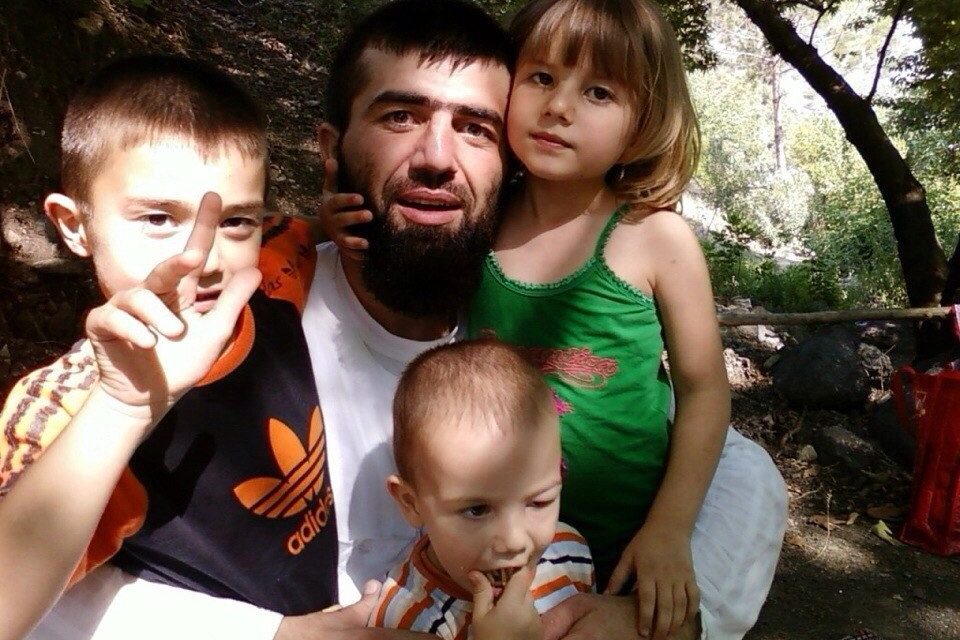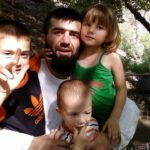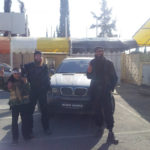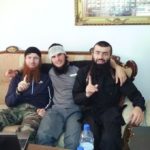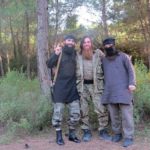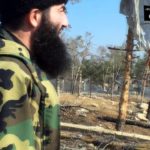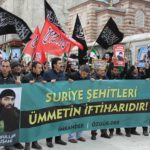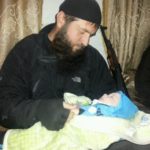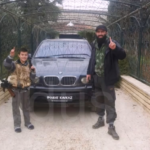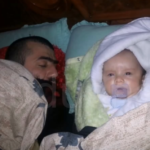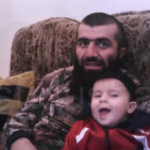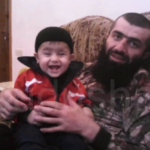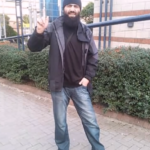Russian jihadi sites were abuzz earlier this month with the news that Sayfullakh Shishani, the eccentric, seemingly unstable, black-bearded Chechen jihadi fighter, had been killed in the storming of the Aleppo Central Prison.
The leader of Jabhat al-Nusra, Abu Mohammad al-Jolani, issued a tribute to Sayfullakh, saying that he had agreed to swear allegiance to the faction only if he were allowed to participate in the storming of the prison.
See Jabhat al-Nusra Leader Gives Eulogy To Chechen Fighter Sayfullakh Shishani
Even FiSyria, the site close to Umar Shishani — who had a very public falling-out with Sayfullakh in August — noted his death, saying they had “received news” of it.
Meanwhile, news began to emerge of Sayfullakh’s life before Syria.
I had already managed to glean some details — such as Sayfullakh’s residence for some time in Turkey — from video footage produced of the fighter by his comrades. An informed source told me that Sayfullakh had no fighting experience before he came to Syria and identified him as Ruslan Machalikashvili from the Pankisi Gorge. However, these new images and snippets of information helped weave a fuller picture of the black-bearded oddball who left a secular life in Turkey to become a religious jihadi in Syria.
See Chechen Emir Seyfullakh Urges Turks, “Don’t Stay Silent Against Muslim Bloodshed”
Photos of Sayfullakh taking part in a pro-Chechen demonstration in Istanbul were circulated on Russian pro-jihadi sites. Other pictures showed pro-jihadi Turks and Chechens with posters of Sayfullakh. Russian forums began to talk about Sayfullakh’s son or sons.
- Ruslan with his family before he became Sayfullakh
- Sayfullakh in Istanbul and a pro-Chechen rally before he came to Syria
- Sayfullakh in Istanbul
- Sayfullakh in jeans after he first came to Syria.
- Sayfullakh with Umar and his son.
- Sayfullakh with Umar Shishani (left) in Umar’s villa in Hraytan, Aleppo
- Sayfullakh with Umar before August
- Sayfullakh with Muslim Abu Walid Shishani after Umar expelled him from Jaish al Muhajireen
- Sayfullah with a woman identified as his Chechen wife.
- Seyfullakh is laid to rest after being killed by a stray bullet or shrapnel near the Aleppo Central Prison
- A pro-jihad rally in Istanbul glorifies Sayfullakh
- A fighter with a baby identified as Sayfullakhs son, after his death in Aleppo
The pictures do not tell the whole story. There is still a great deal of information missing about Sayfullakh/Ruslan. But what we can see are small pieces of the story of a family man who wound up in Istanbul, where he continued to feel a deep connection with the Chechen cause.
This was a man who did not have a regular job, who may have engaged in petty crime, perhaps even dabbling on the edges of organized crime. A photograph of him from that time shows him posing against a BMW, wearing a then-fashionable pair of pointy-toed shoes.
At some point, Ruslan became attracted to and involved in Salafi-jihadi ideology. Was this through an increasing attraction to the Chechen cause, and because of people he met through that involvement? We do not yet know, but we do know that Sayfullakh drifted from Turkey to Syria in late 2012, where he soon met a fellow ethnic Chechen from the Pankisi Gorge — the charismatic, ginger-bearded Umar Shishani.
It seems that Ruslan traveled to Syria with his family. There are photographs of him with several children in Syria – included in the gallery below – though there are also other claimed photographs of a child in Istanbul identified as his son at a rally after his death.
It is likely that Ruslan adopted his nom de guerre of Sayfullakh — “sword of Allah” — in Syria, but Photos of the newly-created Sayfullakh the Jihadi soon after his arrival in the country do not show a particularly religious man. He is dressed in jeans and t-shirts, hanging out with other Russian-speakers who came to Syria looking for something. What?
- Ruslan/ Sayfullakh shortly after his arrival in Syria.
- Ruslan/ Sayfullakh shortly after his arrival in Syria.
- Ruslan is already transforming into Sayfullakh, letting his beard grow
It is likely that, already in Turkey and longing to fight for the Chechen cause, it was relatively easy for Sayfullakh and others like him to reach Syria.
Certainly far easier than going to Chechnya or Dagestan.
And once there, it was easy enough to transpose the Syrian cause onto the Chechen cause, via a simple process of imagining both as part of a global jihad fought by Muslims against the “infidel” oppressors.
Sayfullakh fast became Umar’s right-hand-man. Photographs show the two men together on a variety of occasions — hanging out at the villa in Hreitan that Umar appropriated from a Syrian businessman, next to a car with a “Imarat Kavkaz” license plate (an indication that at least at first, Sayfullakh and Umar identified themselves as fighting for the Chechen cause).
Last August, there was a dramatic change. Umar suddenly expelled Sayfullakh from his jamaat, Jaish al-Muhajireen wal Ansar. What happened? It is not clear. Umar accused Sayfullakh of “fitna”, though it is most likely that the outspoken and unstable man had a fight with the commander, perhaps threatening his authority.
Cut loose, Sayfullakh joined up with another Chechen fighter, Muslim Margoshvili or Muslim Abu Walid Shishani, a veteran fighter who fought in Chechnya and Dagestan before fleeing to Turkey and ending up in Syria.
By this time, Sayfullakh adopted a more religious look and dress. The jeans were replaced by more traditional robe-style garments, sometimes with military-style wear. His speech — halting at best and peppered with the Russian filler word “koroche” (“in short”), an equivalent to the English “like” — was now full of religious Arabic phrases, “alhamdulillah”, “subhan allah”.
For a short while, Sayfullakh ran his own small jamaat, Jaish Khilafatul Islamiyya, and sometimes fought alongside Muslim Shishani’s Jundu Sham faction. By late November, however, he and his men were fighting alongside Jabhat al-Nusra. A video shows Sayfullakh praising Jabhat al-Nusra’s attack on the Kindi barracks in Aleppo, but it is notable that he quickly begins to talk about the Chechen cause, threatening Chechen leader Ramzan Kadyrov.
Despite his falling-out with Umar — the two former comrades never managed to reconcile —- Sayfullakh refused to join in attacks on ISIS, which Umar joined formally in December.
Instead, the increasingly-religious Sayfullakh pledged allegiance to Jabhat al-Nusra and insisted on fighting in the storming of Aleppo Central Prison. His rationale was a religious one: he said he wanted to free Muslims from the infidels’ oppression.
Another photograph of Sayfullakh from the period shortly before his death shows him with a burka-clad woman. She has been identified as Sayfullakh’s Chechen wife.
Video footage of Sayfullakh taken in the last hour of his life shows him near the Aleppo Central Prison, listening to a religious sermon. Sayfullakh appears nervous, and unsure of himself, though he joins in with the “allahu akbar” chant.
Within an hour, he is dead, killed not in a heroic attack but by a stray bullet or shrapnel piece from an airstrike that hit him after he and his men reached shelter. His men were all unharmed in that last attack.
This video shows him being buried in a shallow grave near the site of his death (warning – graphic images):
The story of Sayfullakh is incomplete, though I continue to dig for more information. Much of his life remains a mystery. Yet what we see is the story of someone who was mostly a drifter, a refugee, a man who felt a strong connection with the cause of his people.
Sayfullakh’s story is that of someone whose radicalization was not the result of a deliberate recruitment campaign by Al Qa’eda.
Instead, Ruslan the rather unstable, petty criminal and family man became Sayfullakh the jihadi because he wanted an outlet for his anger about the Chechen cause. He did so because it was easy to go to Syria, where he found an easy, black-and-white narrative of good versus evil and fight against that “evil”, where he took up with a group of comrades who spoke his language, and who were also mostly drifters.
Because in Syria, there was no pressure of finding work or trying to fit in. There was a religious philosophy espoused by powerful father figures, and which explained the world in simple terms. And because, in a way, he was able to hit back — albeit indirectly —at what he believed was the root of the problems in his homeland.
This post is part of an ongoing series about Chechen and North Caucasian fighters in Syria.

